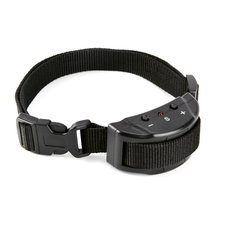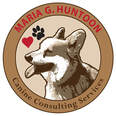|
It’s a fact of life – dogs bark. It’s what they do, as nature intended. Unfortunately for many of us humans, barking is not something we love to hear in our quiet communities or when the baby’s trying to sleep.
A bark collar may possibly deter the barking behavior for just a short while, but it is not a long-term fix. While there are still many traditional-style dog trainers out there who rely on this kind of equipment to modify behavior, one thing they do not take into consideration is the psychological and emotional effect these products can have on our dogs - especially those that are sensitive. Punitive methods that add an aversive to deter a dog’s behavior (referred to formally as “positive punishment”) have been proven to cause other more significant and highly emotional behavior issues, like anxiety and aggression! And to some dogs, the barking has become such a practiced habit that it’s more of an involuntary compulsive behavior, not so much something they are doing on purpose. Using a bark collar in these situations would be kind of like if I zapped you with a Taser every time you sweat when you were nervous. It wouldn’t make you stop sweating, but it would make you more anxious that you knew the zap was coming and you didn’t know what to do to stop it! A more organic (and long-lasting) approach Since a bark collar does not teach the dog what TO do to handle that situation more productively, he will very likely keep making the same mistakes over and over again without any better direction from you (which will only cause you both to get more frustrated). If you really want to curb the barking behavior, the best option is to: Focusing on what TO do and ignoring what NOT to do will help you extinguish the undesirable behavior. Dogs are smart – they will want to keep doing what gets them the most reinforcement! And if you address the underlying cause for the barking, you will be able to diminish the barking in a much more organic (and much less fear-inducing) way and get to the root of the problem so it doesn’t keep creeping up on you. As I mentioned above, there are different reasons why a dog will bark. This is why the first step to curbing the barking is to find out why it’s happening, since you may respond differently based on the reason behind the bark. Below is a quick look at some of the top reasons why dogs bark and what you can do about it. It’s important to note that each dog is an individual. These methods are simplified for the general populous but you may need to add personalized steps for your particular dog. IF YOUR DOG IS BARKING... When he's outside alone: He’s probably bored. Dogs need stimulation to engage their brains throughout the day, and even though there are sights and smells in the back yard, it's still the "same old area" day after day. So after the initial few moments of checking everything out to see what has changed since the last time he’s been out there, this is when a dog will begin barking at anything else new and stimulating - like a bird flying by, a critter he can't reach, the sound of the neighbor getting into their car, etc. The other thing to consider is that dogs are social animals, so being out in the yard by themselves while you are inside is not nearly as much fun for them. Some dogs will bark just to be let back in again. To handle this:
At you, while you're doing something else: He may be trying to say, “leave that stupid [smartphone, TV, etc.] alone and give me some love!” Dogs crave attention – this is no secret. So when they feel they are not getting enough of it, or if their needs have not been met, they might get a little demanding. And if your dog barks at you and you then respond by giving him attention, even if it’s just to say “shhh, stop!”, the dog learns that barking works to give him what he wants. Even “negative” attention is better than “no” attention in his mind! To handle this…
At something/someone out on the street, an unexpected noise, etc: Nature tells your dog it is his job to protect the things that matter most to him. So can you really blame him if he sees or hears something that he thinks may be threatening to you? Your dog cannot always tell the difference between a new guest coming over and an intruder. He may want to signal to other dogs passing by that his home is his space and the other dog is not welcome. And he may want to tell you that the cat just knocked over a vase in the other room, which made a small crash. To handle this alert barking…
Out of fear/"that [item, person, etc] is scary"... Your dog is trying to ward off the “scary” item by making loud noises. This may be accompanied by stiff body language, hackles (the hair on your dog’s neck and back that stand up, forming a Mohawk), and other fearful body language. To handle this…
Out of excitement... Perhaps your dog starts getting yappy when he sees one of his favorite people, while you’re preparing his dinner, or during playtime. Excitement is a natural emotion when your dog has such a positive association with something. You don’t want to take this feeling of excitement away for your dog – you just want to help him learn to handle this feeling a little more appropriately. To handle this…
While there are more reasons that a dog may bark (frustration, pain/discomfort, stress, etc), these are the most common offenders. And some breeds of dogs, as well as individuals, are more vocal than others. With these dogs, you may never extinguish the barking completely, but you can diminish it by giving your dog something better to do. Remember, you do not want to punish your dog for barking or he will start to think that you’re crazy (if he hasn’t already!) and he may even take it out in the form of anxiety or aggressiveness towards you. Using positive methods that utilize recognition of good behavior and redirection will get you finding more harmony in no time! If you would like more specifics about how to help your dog with his barking, contact Maria at (845) 549-0896 or [email protected].
2 Comments
5/26/2017 12:45:04 pm
Maria! You wrote a blog post just for me! :D I love what you have to say about how to curb a dog's natural instincts to bark with proactive and positive reinforcement. Genius! I know who to go to if the training turns out to be too much for me. :)
Reply
Maria Huntoon
5/26/2017 03:10:30 pm
Thank you, Bonnie - I'm glad this post is helpful for you! Please don't hesitate to reach out as needed, and it was so nice to meet you today! :-)
Reply
Your comment will be posted after it is approved.
Leave a Reply. |
AuthorMaria Huntoon, CBCC-KA Archives
April 2020
Categories |
Telephone845-549-0896
|




 RSS Feed
RSS Feed






